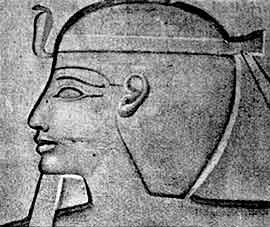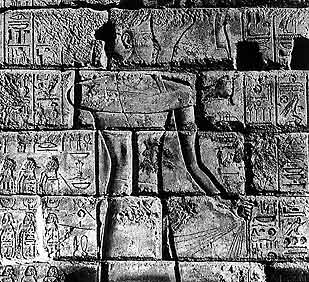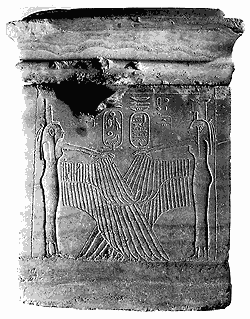|
|
 |
 |
|
|
 |
 |
Originally chief of the Ma (Meshwesh - a group of people with Libyan origins, thought to have been living in Egypt for some time, at Bubastis - it is possible that Herihor was of Libyan origins as were his successors), Sheshonq was a major power during the reign of Psusennes II (a great dedicatory stela at Abydos records Sheshonq petitioning Amun requesting to be associated with Psusennes IIin the great festivals of victory). Sheshonq B (his reference before he became king himself) bore the title of 'Great Chief of Chiefs' and commanded an army.

So strong was Shoshenq B that Psusennes II's daughter, Maatkare B, was married to his son - Osorkon (later Osorkon I). On the death of Psusennes II, and the passing of the 21st Dynasty, Sheshonq I took control of the kingdom and the 22nd Dynasty had begun. Upon taking the throne Sheshonq moved to Tanis - still the capital of Egypt, and soon adopted the Horus, Nebty and Golden Horus names, by doing this Sheshonq kept the tradition of the past. The High Priests to the south in Memphis and Thebes took a little while longer to recognise the kingship of Sheshonq I, in the Priestly Annals at Karnak an inscription begins: 'Regnal Year 2, 3rd month of Akhet, day 17 of the Great Chief of the Ma, Shoshe(n)q, justified'. It was not until Year 5 that Thebes finally gave Sheshonq his full pharaonic titles.
Taking Control of Thebes
Sheshonq I soon placed his second son, Iuput, as High Priest at Thebes (his titles also included Generalissmo and Army-leader, and later Governor of Upper of Egypt). Other previous power-bases in Egypt were also put under closer control by Shoshenq, at Hierakleopolis another son of the king, Nimlot B was appointed military governor, while at Memphis the king's brother-in-law Shedsunefertum A became High Priest.

Campaigns
In the Second half of his reign Sheshonq I launched the first Egyptian campaign into Palestine since the late Ramesside period, leaving Egypt in the control of his sons. A long list of towns attacked by Shoshenq I were carved in the temple of Karnak (including the probable name of Jerusalem - a name which David Rohl contends stating that it is not listed at all), Brugsch-Bey lists the towns as:
|
Ra-bi-tha
(Rabbith) A-do-msa
(EDOM) |
A-do-msa
(EDOM) She-nai-aa |
Ha-ni-ni-au Pa-Ha-ga-lau, 'the stone of' A-le-qad A-do-mam-t Ha-ni-ni A-do-rau Pa-Ha-ga-1 Thel-uan Ha -i - do-baa Sha-li-n-laa Ha-i-do-baa Di-ua-thi Ha-qe-le-ma A-l-daa-(t) Ri-bith A-l-daai Neb-tath Jur-he-ma Ari. . . m A-d-raa Pa-Ba-aa Ma-he-gaa . . ariuk Freth-maa A-bi-r Bal-ro-za Beith-A-n-th (Beth-anoth) Sha-r (?)-ha-tau A-ro-ma-then (Ramah ?) Ga-le-naa A-ro-ma . . . .... r-bath .... raa Ma . . . A-li .... Jula .... |
The accepted traditional view is that Jerusalem is listed, and for evidence a passage from the Old Testament First Book of Kings:
'In the Fifth Year of King Rehoboam, .... Shishak (i.e. Shoshenq) King of Egypt, came up against Jerusalem. He took away the treasures of the House of Yahweh, and the treasures of the house of the king: he took all. He took all the golden shields that Soloman had made'. - treasures possibly including the Ark of the Convenant, remember 'Raiders of the Lost Ark'!
Sheshonq then campaigned further northward until he reached Megiddo, the very place that 500 years earlier Tuthmosis III had recorded a famous victory, here Sheshonq erected a victory stela.
Returning to Karnak, a large wall was built to record Sheshonq's recent campaigns - the Buabastite Portal, this was also decorated with scenes of the king and the High Priest Iuput. While work was still being carried out to these new features, Shoshenq died leaving many sections unfinished.

The Burial place of Shoshenq I
There is some confusion over the exact location of Shoshenq's burial, thought to have been buried in the tomb of Osorkon II at Tanis (who did rule until one hundred years after Shoshenq's death), the only funerary equipment of his that has been found is a canopic chest. It has also been speculated that he could have been buried elsewhere at Tanis, or even at Bubastis - the starting point for Sheshonq I.
|
The Canopic Chest of Sheshonq I The only item of Sheshonq's funerary equipment that has been found. The only example of a style of canopic chest that dates from the 22nd Dynasty (other kings of the period have wooden chests), it seems to have been modelled on an earlier 18th or 19th Dynasty type. Unfortunately this chest appeared on the antiquities market and there are no clues as to its origin. ** - In the tomb of Shoshenq III at Tanis fragments of two canopic jars have been found bearing the name of Shoshenq I. As these jars would be too big to fit in the Canopic chest of Sheshonq I, it has been suggested by David Rohl that this may suggest that there may be another as yet undentified Shoshenq waiting to be discovered. |
 |
